Richard Linklater is making Fast Food Nation into a fictional story? Come again? What’s next….French Women Don’t Get Fat as a thriller starring Jet Li? If the hoi polloi who can’t be bothered to read and who continue to patronize the sludge peddlers want to remain ignorant, why make a movie just to reach them? I don’t get the concept of inventing characters in order to lightly touch upon the ideas so thoroughly explored in the book. Then again, it’ll probably still be better than anything from George Lucas.
Kubrick Taschen
Instead of spending 10 bucks to see Adam Sandler clobber prison guards this weekend, think about dipping into your slush fund and coughing up a portion for The Stanley Kubrick Archives (Taschen). Take it home and bolt your doors and let it seep in, page by lustrous page.
I’m so in love with this thing that I packed it in my suitcase earlier this month and hauled it all the way from Los Angeles to New York, and then up to my parent’s home in Connecticut. I almost took it with me to the Cannes Film Festival. It’s my best friend, my rock `n’ roll, my lump-in-the-throat. I haven’t felt this way about a mere possession in a long, long time.
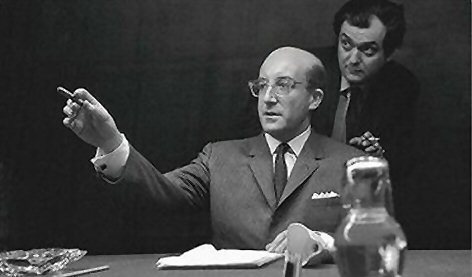
Stanley Kubrick (r.) directing Peter Sellers in his President Merkin Muffley guise on the set of Dr. Strangelove, or How I learned to Stop Worrying and Love the Bomb.
I’m not buying the claim on Amazon.com that this 544-page beast weighs 14.6 pounds. It felt like at least triple that when I was lugging it around Kennedy Airport.
The cost weighs pretty heavily too. 200 dollars, according to the Taschen website. But if you’ve ever thought about laying down serious coin for a first-rate coffee-table book, this might be the deal-maker. Besides, you can get it on Amazon for only about $125. I’ve blown $125 on things that I wasn’t all that thrilled about the morning after. I know I’m going to feel good about having this book twenty years from now.
< ?php include ('/home/hollyw9/public_html/wired'); ?>
Of course, you have to be a fool for Kubrick’s films in the first place. You have to get the Kubrick thing altogether, which means not just worshipping Paths of Glory or Dr. Strangelove or admiring most of Barry Lyndon, but also coming to terms with Eyes Wide Shut, which wasn’t easy at first but I got there.
I did this by facing up to the fact that resistance was futile. I’ve watched that red-felt pool table scene when Sydney Pollack explains the facts to Tom Cruise over and over, and I don’t even know why exactly…it’s like voodoo.
I presume this same susceptibility has enveloped most of the readers of this column.
The Archives text — articles, essays, interview excerpts, all kinds of data — has been edited and assembled by Alison Castle. It’s all smart, elegant and informative stuff, but this is par for a book of this size and scope from Taschen, the Rolls Royce of prestige publishers.

It’s the purely visual stuff that does it to you, in a strategy that mirrors that of Kubrick’s films. There are something like 1600 images in this thing — 800 immaculate frame blowups from all the films, and another 800 behind-the-scenes stills and various “items” (drawings, script notes, letters), most of which have never seen before. Plus essays by Kubrick scholars Michel Ciment, Gene D. Phillips and Rodney Hill
There are two keepsakes in The Stanley Kubrick Archives that are nearly worth the price alone: a twelve-frame film strip from a 70mm print of 2001: A Space Odyssey, taken from a print in Kubrick’s private vault, and a CD containing a 70-minute audio interview with Kubrick by Jeremy Bernstein in 1966…when Kubrick was at the summit of his powers.
All through my first reading I was feeling envious of Castle, who was given complete access by Kubrick’s widow, Christiane, and his longtime producer and brother-in-law, Jan Harlan. What an amazing job she had for two or three years.
All those details, all that minutae…and she and the Taschen editors only got one little thing wrong. I’m referring to a photo taken on the Spartacus set that identifies costar Rudy Bond (who played a loud-mouthed gladiator, although for some reason this role isn’t listed on his IMDB page) as the film’s producer, Edward Lewis. There’s a very slight chance I’m wrong about this (Lewis may have been a dead ringer for Bond), but I doubt it.
This is a spa book…something to sink into and be replenished by. And yet it’s not quite the ultimate down-to-the-bone Kubrick book of all time. It’s more the ultimate Kubrick massage…a thinking person’s pleasure cruise…a first-class voyage into a very sumptuous and particular world.
It’s been called the most comprehensive book on Kubrick thus far. It is that, but in a selectively affectionate way.
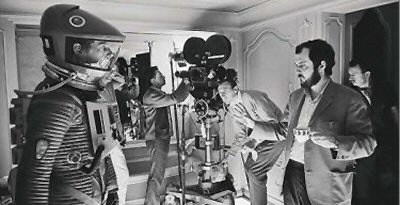
Is it the most penetrating exploration of who Stanley Kubrick really was, and what his life and work finally amounted to, warts, missed opportunities and all? That’s not the intention here.
Does it explore the conflicts Kubrick had with Marlon Brando in the development of One-Eyed Jacks, which resulted in Brando firing him? I would have loved to have read something specific about this, but no.
Does it get into the specific clashes Kubrick had with Kirk Douglas over the making of Spartacus? Here and there, but not to any great detail.
The best books about artists should not only celebrate but dish some rude stuff here and there.
It’s been reported before that Douglas was offended by Kubrick’s pre-production suggestion that he, Kubrick, be given screen credit for Dalton Trumbo’s script, since Trumbo, it was assumed at the time, couldn’t be given this due to his blacklisted screenwriter status. (Douglas eventually gave Trumbo this credit, which helped to end the blacklist era.)
Was this the only reason that Douglas referred to Kubrick during a 1982 interview I had with him as “Stanley the prick”? Douglas was famously egotistical and a scrapper, but I always wanted to know more about his and Kubrick’s relationship.
I guess what I’m saying is that Archives would have been a tad more interesting if Castle and Kubrick’s family hadn’t been so fully committed to the late director’s perspective and had brought in a few naysayers or nitpickers for added flavor.
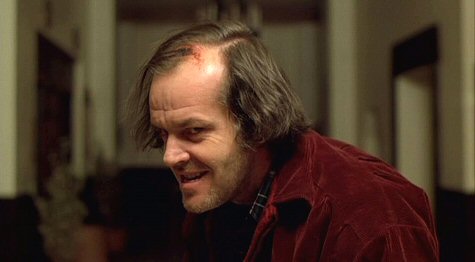
Does it take a hard look at Kubrick’s fastidious, increasingly isolated way of living and working, removing himself more and more from life’s rough and tumble as he got older…more exacting, more of an aesthetic unto himself? Again, not the shot.
Does it ponder the regrets and might-have-been’s and shortfalls? Somewhat, but family-sanctioned tributes are never about tough love.
It would have steered in this direction if I had been the editor. Not to take Kubrick down (I’m as much a fan as Castle or anyone else on the team) but to explore the ironies more fully. I’m saying I would have zeroed in on the paradoxical lesson of Stanley Kubrick’s life and career, which is that absolute creative control can have its downside.
The truth is that the more he became “Stanley Kubrick,” the more he ate his own creative tail. Kubrick became powerful off the success of Dr. Strangelove and 2001: A Space Odyssey in the 1960s. This led to the carte blanche support he enjoyed from Warner Bros. starting with the making of A Clockwork Orange, which in turn allowed him to follow his intrigues to his heart’s content. But this became both his salvation and his trap.
This is an old tune with me, but as watchable as his movies are and always will be, the more remote and mercurial Kubrick became the more rigidly mannered his films were. This is why I’ve always been more of a fan of his work period from The Killing to A Clockwork Orange than the last 24 years of his career, during which he produced only four films — Barry Lyndon , The Shining, Full Metal Jacket and Eyes Wide Shut.
I realize that the emotional bloodlessness of Barry Lyndon is partly what makes it a masterwork, but you can’t tell me Kubrick’s personality wasn’t at least a partial ingredient in this.
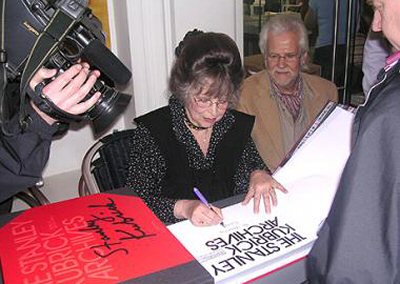
Christiane Kubrick signing copies of The Stanley Kubrick Archives a few days ago in London. Her brother Jan Harlan, who produced Kubrick’s later films, sits to her left.
The opening 20 or 25 minutes of The Shining are among the spookiest ever captured in any film (that interview scene between Jack Nicholson and Barry Nelson is sheer perfection) but the very last shot, the one that goes closer and closer into that black-and-white photo of Nicholson’s Jack Torrance celebrating at an Overlook Hotel black-tie ball in the 1920s, is metaphysical claptrap. It’s a terrible ending.
(I was one of the few who saw a version of The Shining with an excised scene between Nelson and Shelley Duvall that comes right before this shot — Kubrick cut it before the film went into general release. I don’t have the book with me as I’m writing this, but I don’t think it makes any mention of this last-minute edit.)
(And while we’re on the subject, it would have been really special if the book had included frame blowups from the reported five minutes or so from 2001‘s “Dawn of Man” segment that Kubrick trimmed out just after a critics preview. But it doesn’t.)
The labored dialogue in the Vietnam portions of Full Metal Jacket (like “I say we leave the gook for the mother-lovin’ rats” or “Am I a heartbreaker? Am I a…whoo-hoo!..life-taker?”) makes Jacket feel like some kind of stage production rather than something actually going down in that war-torn region in the late ’60s. I read somewhere that some of the actors (Adam Baldwin, for one) bitched behind Kubrick’s back about this, or maybe to his face…I don’t precisely recall.
And yet that final battle sequence (going after that female Vietcong sniper in Hue) is breathtaking.
Don’t get me started on Eyes Wide Shut, but Kubrick’s belief that he would get an R rating (which he was contractually obliged to deliver) for that mansion-orgy sequence footage indicated a man who had stopped taking the pulse of things outside his country estate.
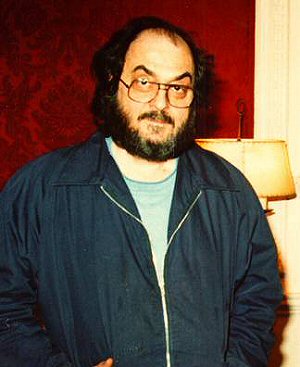
Kubrick at his home in January 1984, in a snap taken by a friend.
And yet for a guy hooked on visual fastidiousness and an increasingly misanthropic view of human affairs, Kubrick nonetheless made films that were tantalizing and seductive….each one a feast.
There’s a Kubrick quote in this book that I’m paraphrasing here, which is that the final measure of lasting motion picture art — all art — lies in the emotional.
It comes down to simple visual pleasures…the thought-out, strongly fortified kind that has led me to watch the Barry Lyndon DVD 15 or 20 times, even thought I don’t care very much for the funereal tone of the film’s second half. I sit through it because I love the Lord Bullington duel sequence and the final epilogue card that states, “Rich or poor, happy or sad, they are all equal now.”
I wouldn’t want to suggest that The Stanley Kubrick Archives is too softball. It is what it is, and that’s a hell of a thing.
The second half takes you in to Kubrick’s deliberative mind more thoroughly (i.e., more personally) than anything I’ve read. From the perspective of first-hand creative immersion, of recreating a world as the artist himself tried to know it and lick it as best he could, it’s one of the finest books on a film director ever published.
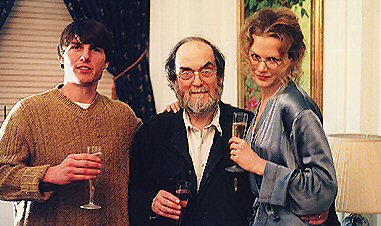
Tom Cruise, Stanley Kubrick, Nicole Kidman on the set of Eyes Wide Shut. It never occured to me before reading this book that Kubrick was on the short side, or shorter than Cruise anyway.
Slightly Gentler Neil
I was so traumatized by the weakness of the dollar during my stay in London last Saturday through Tuesday that I was having anxiety attacks the whole time. I did a lot of speed-walking and visiting different internet cafes and questioning my dumb impulsiveness in flying there in the first place. I didn’t eat anything except fruit and coffee and fast food….awful.
And yet in the face of this I decided last Monday night to see Neil Labute’s Some Girls, which opened a day or two later. I’d missed Labute’s last two, Fat Pig and This Is How It Goes (which both played in New York), as well as The Mercy Seat and The Distance From Here, which I didn’t even know about until I read the program. I felt I needed to catch up.

Some Girls costars Catherine Tate, Saffron Burrows, David Schwimmer, Sarah Tate, Lesley Manville.
And I wanted to see how former Friends star David Schwimmer, who began on the Chicago stage, would handle himself in the lead role. Verdict: he’s relaxed and assured and does quite well.
He’s playing a nominally sensitive short-story writer who’s run away from relationships all his semi-adult life, and is now feeling a bit guilty about this as he prepares to get married. So he pays a visit to four ex-girlfriends in four different cities to talk things over and see if any of them are still pissed about anything…anything at all.
He’s really looking to be forgiven or at least hear that he’s not so bad. This doesn’t happen. He gets a good stiff shot of reality from each ex.
Labute’s plays and films are usually about what pigs or weaklings men are in their relationships with women, and in this light the dealings in Some Girls aren’t as searing or corrosive as usual. It’s not lacking in emotional bruisings, but it’s not quite mild-mannered either.
And Schwimmer’s character makes an effort to at least talk a sensitive game when he catches up with the women. But who and what he really is — a serial escape artist — comes through soon enough, and at the end you feel for his young fiance (whom we never meet) because you know what she’s in for.
The one-act play is funny here and there, briskly paced (at roughly 100 minutes) and sometimes very biting. A moderately enegaging piece. But it doesn’t build or develop all that excitingly and it basically leaves you with a “yeah, not bad” reaction. Is it a movie? No, but maybe an HBO or a Showtime thing.
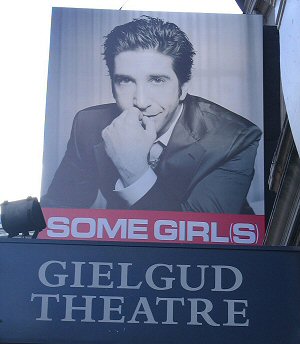
Schwimmer’s first visitation is in Seatlle with Sam (Catherine Tate), whom he dropped just before the senior prom in high school. Married to a local guy who works in a food store and raising kids, she’s still riled about what Schwimmer did (especially his having taken another girl to the prom) and having her emotions stirred.
Then there’s Tyler (Sara Powell) from Chicago, a randy easygoing type who needs a little time to remember what a bastard Schwimmer was to her…and then the anger catches fire.
In Boston he pays a call on Lindsay (Lesley Manville), a married woman he had an affair with behind her busband’s back, and who is also quite angry and looking for revenge.
Finally there’s Bobbi (Saffron Burrows) from Los Angeles, who is hurt but still cares for him…although she’s too smart and proud to open up a second time, even when he tells her she’s the love of his life.
The actresses are all sharp and on top of their roles, and each scene deftly reveals a surprise or two about their past relationship with Schwimmer. LaBute is a gifted writer and psychologically shrewd, but Girls is basically laying out Schwimmer’s history without adding anything urgent or present-tense to it.
Randomly
I was so upset by London I decided to get back to States as quickly as possible. That meant flying Easy Jet from London to Amsterdam for the connection back home, and since I had a few hours to kill I decided to train into town and look around.
I don’t get high so the whole cannabis side of things didn’t hold any appeal, but it’s mildly startling to be in the Abraxas Cafe and see the wide variety of hallucinogenic brownies being sold. Amsterdam is cool but English is spoken so widely and there are so many Brits and Americans running around that the exotic appeal feels diminished for me.
It’s obviously more than just a party town for stoners, but that’s what it felt like during my three-hour visit. Stoners and flower markets (what exactly do you do with a tulip?) and prostitutes and Burger Kings.

Southern sector of Hyde Park near Lancaster Gate — Sunday, 5.22, 5:50 pm.

McDonald’s delicacy available primarily to Londoners.

Four or five blocks due south of London’s Piccadilly Square — Monday, 5.23, 4:45 pm.

Near London’s Sussex Gardens — Sunday, 5.24, 2:35 pm
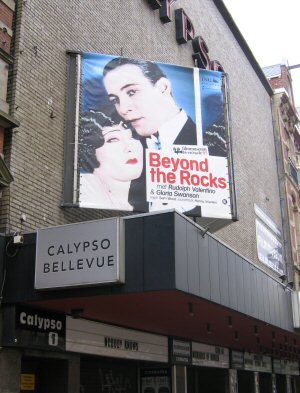
Valentino and Swanson at Amsterdam’s Calypso Bellevue — Tuesday, 5.24, 3:10 pm

Amsterdam — Tuesday, 5.24, 5:05 pm.

Amsterdam — Tuesday, 5.24, 3:50 pm.

Amsterdam — Tuesday, 5.24, 4:10 pm.

Tuesday, 5.24, 10:10 am.
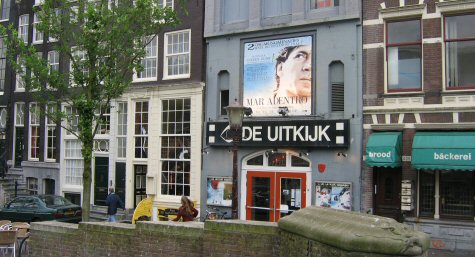
Canal-adjacent theatre in Amsterdam — Tuesday, 5.24, 3:05 pm.

Amsterdam commuters — Tuesday, 5.24, 3:20 pm.

Near London’s Sussex Gardens — Sunday, 5.22, 2:15 pm

Residential street near London’s Sloane Square — Sunday, 5.22, 4:20 pm.
I had begun to entertain the soothing notion that with wi-fi being so commonly available that all the technical mucky-muck that used to be part of getting a new cyber hookup in a new location (like, for example, my modest new swap pad in Williamsburg, Brooklyn, where I’ll be parking it this summer) was a thing of the past. Nice dream. The last day and a half has reminded me that tech hassles are as constant as the moon, not to mention huge gulpers of time…especially when you’re on the receiving end of technical “support” provided by those Indian guys. You know who I mean…those extremely polite, undeniably fastidious, collosally dim professionals who do their part to make life a living hell for so many of us, courtesy of those cost-saving dedicated phone feeds from the land of Gandhi. One of these guys in particular is the main reason why the column is so late today (i.e., Wednesday, 5.25). I don’t need to tell anyone this and nobody likes a whiner, but these guys are a menace. Please send in your own horror stories about tech support from Bombay…I’ll run some on Friday.

In a 5.21 Cannes Journal entry, New York Times critic A.O. Scott wrote that he was “disheartened” by Anne Thompson’s also-recent Hollywood Reporter column which reported/asserted that U.S. moviegoers don’t know and almost certainly won’t care about this year’s big Cannes attractions, much less who their creators are. Her column quoted indie distributors like Warner Independent’s Mark Gill and ThinkFilm’s Mark Urman expressing this realistic (although certainly pessimistic-sounding) view. Scott complained that Thompson’s piece “seemed almost intended to perpetuate the situation it pretends to describe. If you assume that American audiences aren’t interested in certain kinds of movies, and therefore don’t release or write about those kinds of movies, then your assumption will of course appear to be proven right.” The same principle applies to all the whoopin’ and yellin’ over the $300 million-plus earned worldwide thus far by Star Wars: Episode 3 — Revenge of the Sith. If Hollywood-covering editors and journalists were to openly practice advocacy journalism (which of course they don’t — they practice it covertly), they would refuse to report any and all box-office figures for those especially pernicious, grossly disappointing, spiritually polluting movies that come along every so often, like Sith. This is fantasy, of course — you can’t not report about massive box-office earnings anymore than you can omit reporting on huge Asian tsunamis. But one or two local news channels in Los Angeles have talked about refusing to run video coverage of freeway chases and New York Daily News columnist Lloyd Grove has refused to run any more items about Paris Hilton, so there’s some precedent. As God is my witness, showbiz salutations about how the Sith grosses are good and healthy things and that the public has finally and wondrously awakened from its months-long slumber with the release of Sith, blah, blah…these exclamations are feeding the underlying malignancy. To me, these box-office reports seem to almost perpetuate the situation they’re pretending to dispassionately describe. If you assume that American audiences are hugely delighted and/or feel profoundly fulfilled about having seen Revenge of the Sith, and therefore you write about the statistical box-office figures that confirm this assumption, then your assumption will of course appear to be proven right. I have said this over and over in years past, but millions upon millions of easily seducable slackers lining up to see a blockbuster can, depending on the dynamic, mean (and should mean) absolutely nothing in the greater scheme of things. (Which of course if where we should all be living in our heads…in Greater Scheme Land.) What does it mean when a dust storm blows across Kansas and everyone covers their faces and stays inside their home(s)? Is this something to jump up and down about, examine from this and that angle, compare statistically to previous dust storms, and talk about the various ramifications with dust-storm experts like Paul Dergarabedian? People can go to see Sith by the mega-millions and a tip of the hat to those who have shrewdly profited from this, but in a better, smarter and more spiritually focused world, editors and journalists would try to report this dispiriting phenomenon with a bit more perspective…and without quite so much of a “yea, team!” cheerleader tone.
It’s 2 pm on Sunday afternoon in London, and it looks like it’s going to rain. Unusual! If any London readers are in the mood for a pint or two sometime this evening, write me this afternoon and we’ll figure something out. I’ll be checking mail off and on all day.
Flash! You’re reading it here dead last! The surprise Palme d’Or winner did turn out to be Jean-Pierre and Luc Dardenne’s L’enfant (The Child) after all…which I was told might happen just as I was unplugging at the American Pavillion on my final day in Cannes (i.e., Saturday). Hearty congrats to (a) Jim Jarmusch’s Broken Flowers for copping the Grand Prize, (b) Tommy Lee Jones for taking the Best Actor award and Guillermo Arriaga winning the Best Screenplay trophy for The Three Burials of Melquiades Estrada, (c) Hidden‘s Michael Haneke for winning the Best Director award, and (d) Free Zone‘s Hanna Laslo for being named Best Actress. Good calls all around.

I couldn’t file when I got to London last night due to my lodging situation being up-ended when I arrived at the hotel, and then having to scramble around town betwen 11pm and midnight for a place I could afford. The hotel I found (near Sussex Gardens) didn’t have Wi-Fi, of course. (Which is partly what makes places like this affordable.) And the nearby internet cafes start to shut down around midnight, so the hell with it. I walked around in the surprisingly chilly and windy night air and had a really delicious, super-greasy shawarma. I don’t take days off anymore — I take hours off. But it felt like peace.
Returned…
…to these shores late Tuesday night, and currently putting finishing touches to Wednesday’s column this morning, i.e., Thursday. Apologies to those who’ve come to expect a stricter adherence to the schedule.
Dead Beach
It’s straight-up noon on Saturday (5.21), and the aura of finality is everywhere. This is one totally flatlined film festival.
For 94% of the visiting journalists, I mean. Make that 96%. The locals are gearing up for the awards ceremony tonight, which I’ve never attended and probably never will attend.
I’m gone early this evening, which is unfortunate because there’s an opportunity to see the movies I missed (most notably the presumed Palme d’Or winner, Michael Haneke’s Cache) at the catch-up screenings on Sunday.

American Pavilion beach, looking westward — 5.21.05, 10:40 am.
But I’ve had it and I don’t care. I mean, I do care but the spirit rebels and suddenly you need to get the hell out of here.
In the unlikely event that Cache (a.k.a., Hidden) doesn’t win tonight, the surprise winner could be Jean-Pierre and Luc Dardenne’s L’enfant, about some low-life druggies taking care of a baby. I didn’t see this one either. I know, I know.
My favorites were David Cronenberg’s A History of Violence, Tommy Lee Jones’ The Three Burials of Melquiades Estrada, Gus Van Sant’s Last Days (because it’s stayed with me…what you feel and think during the watching of a film is only the half of it), Jim Jarmusch’s Broken Flowers (despite slight reservations) and Woody Allen’s Match Point (because of the great ending).
And I liked Brent Hamer’s Factotum, the Charles Bukowski film with Matt Dillon in the lead role.
< ?php include ('/home/hollyw9/public_html/wired'); ?>
And I loved watching East of Eden last night at the Salle Bunuel. It feels a bit too tidy and 1955-ish at times, but James Dean was a prince and a genius, Jo Van Fleet gives one of the scrappiest female performances ever put on the screen, and Julie Harris’s acting in this Elia Kazan film still breaks my heart.
I never got around to writing anything about Amos Gitai’s Free Zone, which I found half-absorbing (it certainly isn’t the bad film that the Hollywood Reporter guy said it was). I loved the driving-through-Israel-and-Jordan footage, and Natalie Portman gives a performance that’s as grounded and filled out as she was in Closer.
No more filing until Monday or maybe even Tuesday. There’s plenty of stuff to get into that’s been piling up over the last eleven or twelve days.
The Why Of It
I saw Wim Wenders’ Don’t Come Knocking on Thursday morning, and I’m sorry to say I was profoundly unmoved.
I’m sorry because I’ll always admire Wenders for his exceptional films (The American Friend is still my all-time favorite, followed by Wings of Desire) and for the auteurist streak that used to be his handle, but this, lamentably, has ebbed and flowed according to the quality of the project in recent years.

Don’t Come Knocking screenwriter-star Sam Shepard (left), director Wim Wenders at Sony Classics press luncheon at Carlton beach cafe — 5.20.05, 2:10 pm.
Wenders and screenwriter-star Sam Shepard last collaborated together on Paris, Texas (’84). That was a fairly strong, deservedly admired film, and I suppose they thought they could make lightning strike twice, or at least create a few meaningful sparks.
“We decided to fuck with it again,” Wenders said earlier today (5.20) during a press luncheon.
Like Jim Jarmusch’s Broken Flowers, Don’t Come Knocking is about a middle-aged guy on a downturn cycle facing up to all the crap in his life by reconnecting with a woman he used to love (or at least have sex with) in his youth, and also looking to find and perhaps get acquainted with a fully-grown son he never knew he had.
Trust me, Jarmusch’s film is a far, far better thing.
Shepard’s Howard Spence is an alcoholic, self-destructive actor who’s on his way down fast. The film begins with Howard hightailing if off the set of his latest film, a western being directed by a journeyman type in his late ’70s, played by George Kennedy.

This put me off right away. Guys who look like George Kennedy direct television shows…maybe. If they used to be feature directors and their rep carries some weight. But mostly they don’t direct anything because the industry discriminates against white-haired guys of this age, so right away I was saying to myself, “Bullshit.”
I also don’t find alcoholics the least bit interesting, especially ones who walk away from paying gigs for no discernible reason other than the fact that the screenwriter has decided the character is a fool who’s going through a midlife crisis.
Howard stays with his mother (Eva Marie Saint) for a while, who sees right through his bullshit boozy behavior but feels no need to call him on it. She provides the inciting incident, 45 minutes into the story, when she tells Howard that he has a son by Doreen (Jessica Lange), his ex-wife (or ex-girlfriend…not that it matters either way).
Howard makes his way up to Butte, Montana, and meets up with Lange, and she points out his son Earl (Gabriel Mann), a local country music performer.
Earl is black-haired and hugely pissed off and averse to emotional exposure of any kind, which means, of course, he doesn’t want to know Howard. He’s one of those guys given to throwing clothes and furniture out of his second-story apartment when emotions come to a boil.

Don’t Come Knocking costar Sarah Polley.
Howard’s mother has a scrapbook full of newspaper clippings about him, and his fame allows him to score with women he’s just met, but Earl, a 30 year-old, doesn’t know who he is. “What is he, an actor?” he says at one point.
The Cannes-based Hollywood Reporter critic wrote that Wenders and Shepard have yielded “a dry, spare, odd and oddly satisfying drama about a modern-day lonesome cowboy, lost in a desert of his own making, who seeks out salvation by seeking out those he left behind.”
Oddly satisfying? The movie is deeply aggravating. I was sitting there trying to decide when to leave. I wanted to see enough so I couldn’t be accused of missing most of it. I knew I was stuck there for a good 90 minutes or so, but I damn sure wasn’t going to sit through all 122 minutes’ worth.
To me, Knocking is not a Wim Wenders film. It doesn’t have his mood or visual signature or stylistic consistency.
It has an unfocused, shuffling-along attitude that feels way, way off. The script is sloppy and raggedy-assed, although there’s a good scene in which Lange tells off Shepard for being an irresponsible screwup.

Sony Classics honchos Michael Barker (l.) and Tom Bernard — 5.20.05, 1:20 pm.
I asked Wenders to respond to a comment about his film written by New York Times critic Manhola Dargis and published today, to wit: “This deeply sincere film takes place in an American West that bears little relation to the real world, perhaps because that isn’t the America with which [Wim] Wenders first fell in love.
“Like other artists and intellectuals from abroad, Mr. Wenders seems to have fallen for an America that mostly exists on Hollywood back lots and in rock ‘n’ roll lyrics, which probably explains why the romance has lasted so long.”
To this Wenders responded, “I have travelled around this country and gotten to know it better than any film critic I’ve ever met. I don’t think [Dargis] has ever been to Butte, Montana.”
I can’t write any more about this, but I had a swell time at the press luncheon and enjoyed speaking to Wenders and Shepard and costars Sarah Polley, Gabriel Mann and Fairuza Balk (who said I had “an interesting face,” which made me feel funny for some reason.)
I’m just sorry I had such a rough time with the film, and I’m hoping Wenders and Shepard do better next time.

Shepard, Wenders — 5.20.05, 2:05 pm.
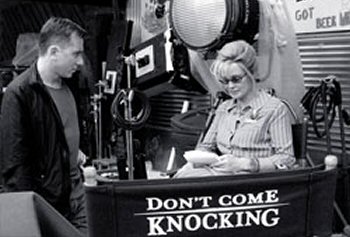
Don’t Come Knocking costars Tim Roth, Jessica Lange on set.

Exquisitely designed cappuccino cup, sipped from and remarked upon by Wim Wenders and yours truly during Knocking luncheon — 5.20.05, 2:20 pm.
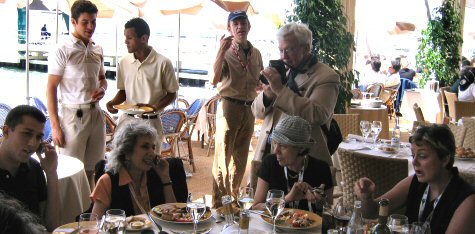
Roger Ebert (third from right, standing) snapping photos before start of Knocking luncheon. Variety critic Todd McCarthy (gesturing, wearing cap) stands to Ebert’s immediate right.
Respecting a Dead Guy
I’ve agreed not to wade into Tommy Lee Jones’ The Three Burials of Melquiades Estrada until 10:30 pm Thursday (Cannes time) and it’s only around 7 pm now, so I’ll have to write this a certain way.
I think it’s fair to say what other journos are saying, which is that they’re very admiring, and that some (like the Toronto Sun‘s Bruce Kirkland) are surprised at how smartly composed and compassionate and thematically rich it is.

The Three Burials of Melquiades Estrada producer Michael Fitzgerald (left, avec beard), director-producer-star Tommy Lee Jones (center) and Toronto Sun critic-reporter Bruce Kirkland at Thursday’s press gathering at a wonderfully picturesque and soul-soothing villa in the hills above Cannes — 5.19.05, 12:35 pm.
Surprised because you never know what to expect from a first-time-out director **, especially when he’s a famous actor. It could have been indulgent or precious or half-baked.
But then Jones is a very intense, exceptionally bright, very passionate hombre, so his having scored with top-level journos shouldn’t be that surprising. Especially with Jones basing the film on an obviously thoughtful, time-shuffling script by Guillermo Arriaga, who wrote Amores Perros and 21 Grams.
I think it’s also fair to report that I attended an American Pavilion interview late Wednesday afternoon between Jones and Roger Ebert. Ebert made it clear he’d had a positive reaction to the film. He also asked if anyone in the audience had seen it, and when I raised my hand he asked me what I thought and I offered a thumbs-up gesture.
I don’t know if Melquiades Estrada is going to stand up against the supposed Palme D’Or favorites thus far, which are Michael Haneke’s Cache (which I missed last Saturday, and hasn’t, as far as I know, been shown since), David Cronenberg’s A History of Violence and Jim Jarmusch’s Broken Flowers.
It may (I say “may”) be received as more in the realm of being very good or worthy rather than masterful (there’s a prominent critic for a monthly who, according to a Texas-based critic, feels it falls apart during the second half), but I wouldn’t be surprised if the buzz is better than that.

The Three Burials of Melquiades Estrada costars Barry Pepper and January Jones at press table, as Pepper reads from a diary-journal he wrote during production. In it he described Tommy Lee Jones as “a Southern badass with a ruthless work ethic and a heart the size of the Copper Canyon.”
The Three Burials of Melquiades Estrada is a modern-day tale set in western Texas and northern Chihuahua, Mexico. It deals with a ranch foreman (Jones), a border patrolman (Barry Pepper) and an illegal immigrant named Melquiades Estrada who works for Jones. The second half is a horseback-journey film about redemption and seeing through prejudices and imbedded attitudes.
It’s a film with a great deal of compassion and soul and a generally humanistic view of things. If you want your literary influences, check out Flannery O’Connor’s work and William Faulkner’s “As I Lay Dying.”
In the press kit, Arriaga says he wanted “to make a study in social contrast between the land that’s south of the Rio Grande river and the land that’s north of it. About what iron ies, injustices, glory, beauty and redemption you can find in this area that has its own character…something that cannot be imposed, something that has grown and evolved… something that cannot be controlled.”
Just before 11 am today myself and a few other journos (Kirkland, Stephen Schaefer, Desson Thomson, Harlan Jacobson, Shari Roman, etc.) were driven in a minivan from the Gray d’Albion hotel near the Croisette into the hills above Cannes, and eventually (the driver got lost) to a beautiful hilltop villa.

Guillermo Arriaga, hunting buddy of Tommy Lee Jones and screenwriter of The Three Burials of Melquiades Estrada (as well as 21 Grams and Amores Perros.
The purpose was to allow for a brief schmooze with Jones, Arriaga, Pepper, young co-star January Jones and producer Michael Fitzgerald (whose other ventures include Colour Me Kubrick and Sean Penn’s The Pledge).
Pepper said that Jones “has a very deep passion for strong visual composition and the poetry of words.” He read some passages from his on-set journal, and on one page he described Jones as “a Southern badass with a ruthless work ethic and a heart the size of the Copper Canyon.”
He mentioned two things that Jones told him before shooting a couple of scenes — “Keep it stupid simple” and “don’t do somethin’, just stand there.”
I mentioned to Jones, Arriaga and Fitzgerald that since seeing their film on Wednesday I’ve had trouble remembering the exact title. I like the earnest writerly sound of it — it doesn’t sound like your standard test-marketed title — but there is something about the name “Melquiades Estrada” that won’t stick in my brain, and I’m not trying to sound like a xenophobe when I say that.
Somebody asked Jones and Fitzgerald about the U.S. distribution prospects, and Jones said that “the wheels of commerce are turning as we speak.”
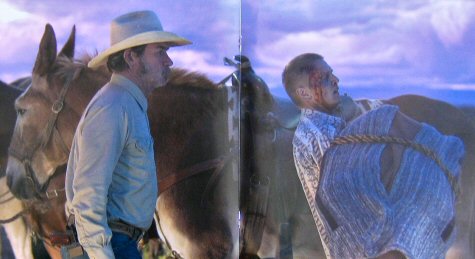
Tommy Lee Jones, Barry Pepper in scene from The Three Burials of Melquiades Estrada, taken straight from an image in press book (i.e. laid flat on the rug at the American Pavilion, and then cropped and refined).
Jones was asked to articulate the film’s themes, but he’s not what you’d call a press-junket gabber. Aside from calling it “a journey toward redemption,” he said, “You’re invited to read into it anything you deem appropriate…all you want, all you want.”
Pepper said that Jones read aloud from the book of Ecclesiastes during shooting. Jones was later asked why. “Because I like the book,” he replied.
His philosophy of directing actors, he said, is the same attitude he brings to handling a horse, which is “never ask a horse to do what it can’t do.”
Jones was asked what doesn’t work on the setas far as directing is concerned. “Tantrums are not constructive,” he said. “Egotism is not, I think, a good thing.”
He said he’s long wanted to direct a film of Cormac McCarthy’s “Blood Meridian,” and was asked a few years ago by then-Sony chief John Calley to write an adaptation of it in script form. He delivered it a year later but “they said it was too violent,” he said.

View of Cannes and the Med from EuropaCorp-rented villa, the site of Thursday’s press junket for The Three Burials of Melquiades Estrada.
The session ended after an hour or so, and everyone was driven back to town.
A journalist I spoke to near the front of the Gray d’Albion said I should have snapped a photo of January Jones when she was eating a banana at our press table. He was struck by this act of consumption for obvious reasons.
A wafer-thin and very beautiful brunette woman who does interviews for French TV sat next to me in the van on the way back. She was dressed in a sheer white dress and smelled like jasmine mixed with musk.
I glanced at a printed itinerary she was holding in her hand, and I saw that she had three hair and makeup appointments set for today — one at breakfast, a second just after lunch and a third before going out this evening.
Numbers
There is no more time at all…none…but the caption says it all. I’ll try and amplify tomorrow morning:
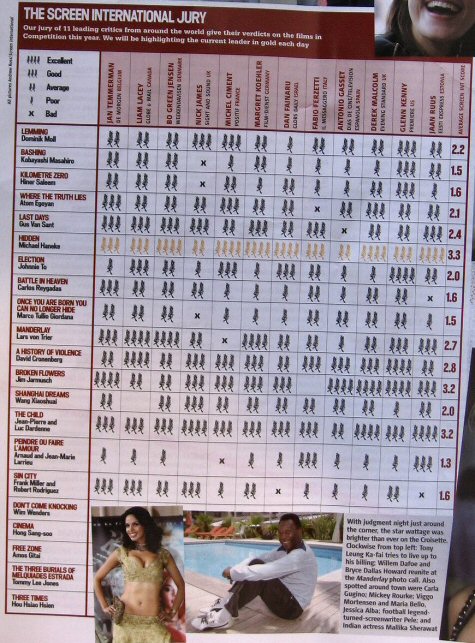
Screen International‘s poll of mostly European critics (and no Americans) still had Michael Haneke’s Cache (a.k.a. Hidden) at the top of the list of Palme d’Or contenders as of Wednesday, 5.18, in a graphic published in Thursday’s (5.19) issue. Notice that the Jim Jarmusch’s Broken Flowers is running a very close second. Tommy Lee Jones’ film was shown for the first time late Wednesday morning, and therefore didn’t figure. To what degree do these conclusions reflect the sympathies of the Palme d’Or jurors? I couldn’t say, but they do indicate what a lot of people I’ve spoken to myself are saying. Notice also that Pendre ou Faire L’Amour, which I walked out on, has the lowest ratings of all.
Beached!
I was taking a break yesterday (Thursday, 5.19) on the beach in front of the American Pavilion when I spotted two guys cruising along about 100 years out in the bay in some kind of watercar — an engine-driven car with tires and windshield wipers and everything else that floats and can be driven across the water.

Didn’t I see one of these in a James Bond film back in the early ’90s? Or in some Herbie or Love Bug remake from Disney?
Anyway, the two guys and their watercar started heading for the beach. Paddle, paddle…blub, blub, blub….so far, so good.

Then the tires hit the sand and they started spinning out. The slope of the beach is very gradual and slight, but the car couldn’t get any traction. They kept trying, accelerating, spitting water into the air ….failure.
The various onlookers on the beach began to laugh and joke with each other and point at the beached jalopy. Dumb invention! Back to the drawing board! How very quickly and suddenly the love and support of the public evaporates.

Fact
When I made my first trip to the Cannes Film Festival in ’92, topless women on the beach were a common sight. I used to love to stop for a minute or two and pretend to look at the water and sky and everything else except these women, and there were always several to gaze upon.

But nowadays it’s rare to see a bevy of women lying around topless. I noticed exactly two earlier today, and it’s very sunny and warm out. I think this signifies something. French culture is turning more covered and conservative, apparently…but why? This demands further thought. If anyone has any theories, please send them along.
Do you literally have to live in the U.S. to knock its values or criticize its culture or politics? David Cronenberg, a Canadian whose recently-screened A History of Violence addresses America’s shoot-em-up, fistifcuff tendencies, is quoted thusly by L.A. Times critic Kenneth Turan: “Does a fish know about water? Living in a tributary, not the ocean, [Marshall] McLuhan had a different perspective. The insights he had into America would not be possible to anyone living in America. Stepping away has a lot to do with it.”

A lot of press people in Cannes have been doing their usual ranting against Lars von Trier for making another film critical of the U.S. (i.e., Manderlay) without having ever visited American shores. Certainly one needs to absorb a country’s culture first-hand to get a thorough understanding of what it’s about…but it also seems absurd to insist that a visitation has to happen before one can render a strong opinion about a country’s history with a film like…well, Manderlay. As von Trier told the Hollywood Reporter‘s Anne Thompson, “America dominates world culture” and “is a big part of our lives in my country. 60% of the main words in all the experiences of my life are American…I am an American, but I can’t go there to vote [and] I can’t change anything. That’s why I make films about America.”
“The general opinion of Revenge of the Sith seems to be that it marks a distinct improvement on the last two episodes, The Phantom Menace and Attack of the Clones. True, but only in the same way that dying from natural causes is preferable to crucifixion.” This from Anthony Lane’s pan in the current issue of The New Yorker. Hail to this fellow…his review is hilarious.
Eight Days In
It’s late Wednesday morning, 5.18, and this signifies, among other things, that the Cannes Film Festival started a week ago and there’s another couple of days to go before everyone collapses into a heap.
This morning’s competition film, Peindre out Faire L’Amour (To Paint or Make Love), did nothing for me or to me. It’s another one of those leisurely paced, mezzo-mezzo domestic French dramas about middle-class, middle-aged people, and I’m sorry but I couldn’t abide it.
I know it sounds lazy and arrogant to dismiss a film like this without giving it its proper due, but I’m just being honest. I have enjoyed films of this type before and I hope to again, but not this morning, Monique.

I took this out-of-focus shot around 8 pm yesterday evening (5.17) aboard a large yacht that Stella Artois beer and the Hollywood Reporter were throwing a party on. (The invite came via courtesy of Gregg Kilday.) Notice the heaving seas — it looks like a rescue scene from Richard Lester’s Juggernaut. And the seas really were heaving and rocking the boat and pitching everything and everyone around, and it was magnificent to be on this little red craft and feel all this natural turbulent energy.
< ?php include ('/home/hollyw9/public_html/wired'); ?>
I’m seeing the rugged outdoor drama that Tommy Lee Jones has directed and starred in, The Three Burials of Melquiades Estrada, at a private screening at noon, but I’ve agreed not to write about it until Thursday, so I don’t know what to do for today’s column.
I hate writing a daily column, but I love nailing it and doing it well when my energy’s up and the synapses are firing away like the spark plugs inside the humming engine of Jimmy Stewart’s The Spirit of St.Louis over the icy north Atlantic at 5 ayem.
People seemed to be getting irritable yesterday, which I attribute to the fact that people always get irritable after going 18 hour days for seven says straight.
If you’re looking for something fresh, please scroll down and check out my new “head” shot. I’ll try and post something intriguing later today.
Mostly
I respected and mostly liked Jim Jarmusch’s Broken Flowers, but I didn’t find it entirely sublime. It felt a bit sketchy and under-fueled and sketchy at times, but that’s Jarmusch for you — a real less-is-more kind of guy. He likes his characters and scenes fairly cut and dried without any of that emotional backstory stuff.
This isn’t to say Broken Flowers doesn’t penetrate. It’s a dryly intriguing comedy, at first, that slowly darkens into a sobering adult drama. The ending isn’t “happy” or tied up in a red bow, but on Jarmusch’s own terms it has integrity, and in fact “works.”
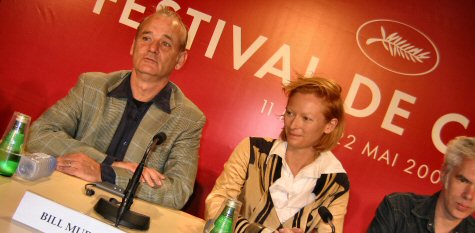
Broken Flowers star Bill Murray, costar Tilda Swinton and (half cropped) director-writer Jim Jarmusch.
The story’s about a middle-aged lonely guy (Bill Murray) flying around the country and trying to figure out which old girlfriend has written him a note telling him he has a 19 year-old son.
All we’re told about Murray’s character, who’s called Don Johnston, is that he’s financially comfortable and emotionally remote. In the film’s early scenes one could call him emotionally shut down — too much so, I felt.
We’re all used to Murray’s half-comic underplaying (which was never better than in Wes Anderson’s Rushmore) but this works best, I feel, alongside higher-energy characters or situations. For the first 25 to 30 minutes, Jarmusch and Murray are almost too synched up for their own good.
The story begins with Johnston getting dumped by his latest girlfriend (Julie Delpy) over emotional remoteness issues, including Johnston’s aversion to having family. Then comes the letter, partly written with a typewriter, and on pink paper inside a pink envelope. The import is that the alleged 19 year-old son may be looking for Johnston.
There’s a hangup, though: the girlfriend doesn’t identify herself. Johnston shows the letter to his next-door neighbor Winston (Jeffrey Wright), a guy with five kids and three jobs who fancies himself as a kind of internet sleuth. Winston asks Johnston to write down a list of ex-flames who might be the mystery letter-writer.
Murray comes up with the names of four women, and Winston finds their addresses and whatnot online. He urges Johnston to visit each and try to learn what he can.
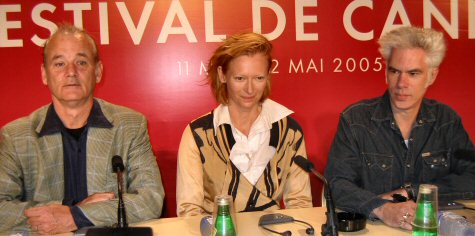
Broken Flowers stars Murray and Swinton, director-writer Jim Jarmusch.
Winston twice tells Johnston that his romantic history qualifies him as some kind of former Casanova. Of course, having had four ex-lovers during the mid ’80s is not especially hound-like. The Great Nookie Shutdown of the mid to late ’80s (caused by fear of AIDS) hadn’t quite kicked in in the early years of the Reagan administration, and single heteros were almost as frisky as they were in the ’70s.
The ex-girlfriends are played by Sharon Stone, Jessica Lange, Frances Conroy (from HBO’s Six Feet Under) and a just-about-unrecognizable Tilda Swinton, covered in a black wig and heavy eye mascara.
The film picks up steam once Murray/Johnston goes on the road and pays a visit to each ex, always offering a bouquet of flowers but saying and asking very little. For some reason, Johnston never puts his cards on the table and just says, “Did you write me a letter on pink paper that said I have a 19 year-old son?” Instead, he hints and tippy-toes around and asks if they own a typewriter.
What’s so bad about posing a straight question? A middle-aged man asking an ex-girlfriend whether he might have a son he never knew about…what’s so gauche or off-putting about that?
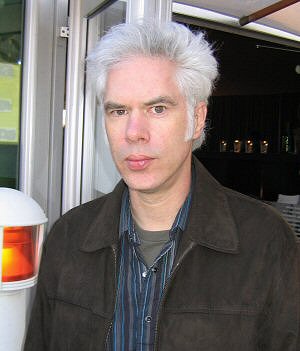
Jim Jarmusch — Monday, 5.16.05, 7:55 pm.
Of course, all the tip-toeing around makes the encounter scenes (and the film itself) about undercurrent — the things people think and do not say.
What’s interesting and finally quite satisfying about Broken Flowers is how Jarmusch doesn’t feel obliged to answer each and every last question, either on the part of Johnston or the audience.
Flowers has, of course, Jarmusch’s signature elements (minimalism, understatement, observings of cultural minutae), and a somewhat taciturn, occasionally hilarious lead performance by Murray.
One of the funnier things Murray does is a carrot-eating scene at the home of Conroy and her real-estate-mogul husband. I’m not going to describe it. I couldn’t.
Wright is fine and believable, although he doesn’t have that much of a part. The standout among the four exes is Swinton, and she has maybe eight or nine lines, if that. Stone, Lange and Conroy are intriguing in their respective turns.
Murray was asked at the press conference about his minimalist acting style, and he said “it comes from deterioration of ability. As time moves on I find I have less and less to give.”

Boiled down, his role in Broken Flowers is about how “I get beaten up by all these women,” he said. “It was a far more precarious thing than I expected it to be. Always being off-balance and feeling unsettled.”
A journalist told Murray he was very scared as a kid when he saw all the spooks and monsters in Ghostbusters. “You’re safe now,” Murray replied. “We took care of all that.”
Another guy asked Murray an extremely arcane, hard-to-follow question, and Murray replied, “Are you the same guy who asked me outside a few minutes ago to take on the Argentinean Senate? I mean, why not? I’m looking for work.”
Murray said at another point that “doing that back-story stuff sometimes takes you out of the moment [when you’re doing a scene].”
Jarmusch said he’s “not interested in back-story…my style is looking at details and nuances. My religion is that of the imagination.”
Plantation Blues
Manderlay didn’t do it for me, and I’m speaking as a totally ardent fan of von Trier’s Dogville , Dancer in the Dark and Breaking the Waves, as well as a general fool for his bad-boy provocateur routine.
It’s a relentlessly talky, intelligent and provocative film that addresses…well, American racism, certainly, but more generally a do-gooder tendency by American governments to try and shape other societies so they more resemble our own (Iraq, Vietnam, etc.). And it indulges in the usual proddings and agitations that are par for this Danish filmmaker.
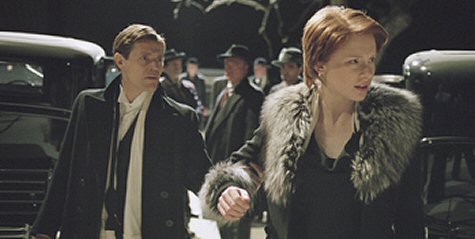
Willem Dafoe and Bryce Dallas Howard in opening scene from Lars von Trier’s Manderlay.
I don’t know when it’ll open in the States, but I’m presuming Manderlay wi ll piss off African-Americans when it opens there for saying, in part, that they are playing (or have played) a willing part in their economic subjugation by whites.
The second installment in von Trier’s America, Manderlay is a continuation of the adventures of Grace, the gangster’s daughter played by Nicole Kidman in Do gville, the trilogy’s 2003 kickoff, and by Bryce Dallas Howard in the new film.
Both films are stagey and pedantically inclined, and shot on what is probably the same massive sound stage with imaginary props and sets. (The third installment will presumably follow suit.)
Manderlay‘s problem is that it’s too similar to Dogville…and not similar enough.
Despite its slow pace and very gradual plot development, Dogville had a surprise character revelation (i.e., that Kidman is the daughter of gangster James Caan, and not his girlfriend, as the film allows us to assume at first) and a shockingly violent finale that expressed von Trier’s negative feelings about what he sees as American tendencies to exploit the less fortunate.
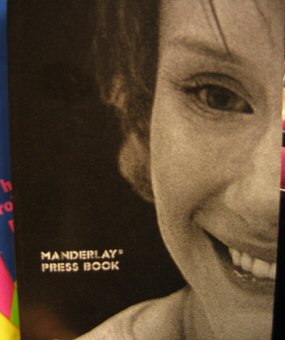
The perfect-bound, pocket book-sized press notes for Lars von Trier’s Manderlay.
Manderlay is supposed to walk, talk and feel like a Dogville companion. It is broken up by titled chapters, John Hurt again provides the dry and pungent narration, and the closing credit sequence is nearly identical with the same David Bowie song (“Young Americans”) played over a series of stills that il laminate the uglier aspects of America’s history – in this instance, the treatment of African-Americans over the last century or so.
But there’s no big jolt or surprise at the finale — you can pretty much tell what’s coming from the get-go – and it so closely recalls Dogville‘s aching-butt aspects that watching it feels like a chore.
Set in the early 1930s, some days or weeks after Dogville ended, Grace and her father (Willem Dafoe, taking over for James Caan) and his gang of thugs pull up out side the gates of an Alabama plantation called Manderlay.
To her shock, the na√É∆í√ǬØve and willful Grace quickly learns that slavery is still in place here — the black workers lorded over by a white family (which is headed by Lauren Bacall). She quickly decides to use her dad’s power to take over the plantation and institute democracy and free choice and self-sufficiency.
But the process of teaching is kind of fraught with contradictions. Grace needs to order and organize and put structure into place, and the black men and women of Manderlay resist or elude her plans in different ways, and old habits revive themselves and Grace gradually ends up becoming a tyrant — just like the slave-running family she replaced.

Manderlay‘s sound-stage set.
She develops the hots for a laborer named Timothy (Issach de Bankole) whom she first saw tied to a post and about to be whipped. She and Timothy eventually submit to their mutual libidinal urges, but he is tied up again by the end of the film and this time Grace is doing the whipping.
She also executes an older woman named Wilma (Mona Hammond) who, it is charged, was responsible for the starvation death of a child.
The bottom line is that Manderlay isn’t punchy or startling enough to justify the two hour and 19 minute running time.
Violence
I meant to write longer about David Cronenberg’s A History of Violence, which I caught Sunday night and liked quite a lot, but I have to postpone writing about it again and it’s two days later.
Viggo Mortensen stars as Tom Stall, a man who leads a relatively quiet, small-town life with his wife (Maria Bello) and two kids.
The truth starts to come out when Mortensen defends a waitress about to be attacked from a pair of thugs, dispatching them with speed and savage efficiency. This act makes him into a news media hero, which brings him nationwide attention.
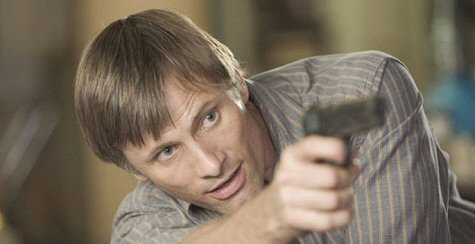
Viggo Mortenson in David Cronenberg’s smartly assembled, suprisingly amusing A History of Violence.
Then it turns out he’s a guy with a criminal past who’s adopted a fake name, and then some of the gangster types he ran with — dark-suited baddies from Philadelphia, including a pair of creepy nogoodniks played by Ed Harris and William Hurt — start showing up and saying, “Heyyyy…”
I was especially turned around by the dark humor aspects. A lot of people get bloodied and shot and killed in this film, but it’s a very funny thing at times, and I wasn’t the only one feeling this way.
There was a French guy in the audience at the Salle de Bussy’s 7:30 pm showing who yelled at the audience while the film was running, saying,in effect, “Stop laughing…this isn’t funny!”

Randoms

Cannes beach in front of Noga Hilton beach annex — Monday, 5.16.05, 7:40 pm.

Enterprising journalist holding an obviously first-rate prosthetic severed head. Head was found sitting on a mantle at a party thrown by and for socially ambitious under-25 Brits on the evening of Tuesday, 5.17, at a faux-castle residence in the eastern section of Old Town.

Carlton Hotel billboard for Cameron Crowe’s Elizabethtown.
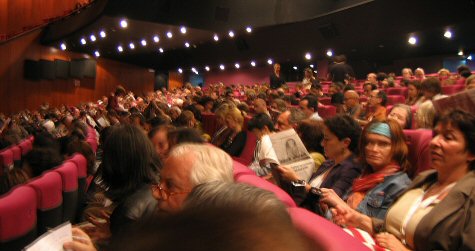
Audience at Salle de Bussy on Sunday evening, just before the lights went down and David Cronenberg’s A History of Violence began — Sunday, 5.15.05, 7:25 pm.

My work station (i.e., lower right, newspaper on keyborad) at the American Pavillion — Monday, 5.16.05, 1:55 pm.

View of rainstorm from American Pavillion — Monday, 5.16.05, 2:40 pm.

London filmmaker Natalie Turner (Sfumato), Channel 4 journalist-critic Annette Dasey at Sunday night’s Star Wars party — 5.16.05, 12:20 am.

Fireworks over baie de Cannes — Sunday, 5.15.05, 11:40 pm.

Death Stars
George Lucas and his digital galactic posse arrived in Cannes Sunday
(5.15), and attracted, to no one’s surprise, more attention than any other film or team of filmmakers who’ve dropped by thus far.
Which is symmetrically appropriate, I suppose, since we all realize that Stars Wars: Episode 3 — Revenge of the Sith will most likely attract more ticket buyers than probably all the other films showing here (including the market offerings) combined.
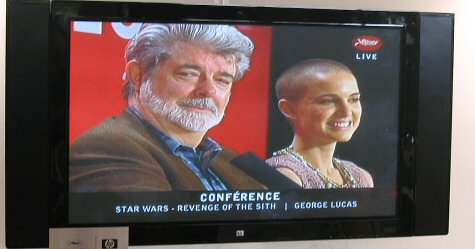
Star Wars: Episode 3 – Revenge of the Sith director-writer George Lucas and costar Natalie Portman during Sunday afternoon’s Cannes Film Festival press conference, which I would have attended if I didn’t have better things to do — 5.15.05, 1:10 pm.
There’s no percentage in being a sorehead and teeing off on George and his unstoppably mediocre film all over again, so let’s just zip it.
The Sith press conference, which just ended about 20 minutes ago (i.e., at 2 pm), was a two-toned affair — the occasional (make that very occasional) journalist asking a somewhat pointed question and Lucas not really answering them, and the other journos asking puffball questions.
Big surprise, right? The world wants to love this film, publishers and editors who employ Cannes-covering journalists know this and just want the standard oooh-ahhh coverage, and who gives a hoot anyway?
Movie City News and Film Stew contributor Sperling Reich asked Lucas why he had made it more difficult for websites and bloggers in recent years to cover Star Wars-related news by not affording them the same access given to print publications. Lucas ignored the question and spoke about his love for the free exchange of information that the internet provides, etc. And Reich didn’t follow up.

I was standing by a big window overlooking the path that Team Lucas (Hayden Christensen, Rick McCallum, Portman, Samuel L. Jackson, etc.) were about to walk by, and I was going to snap a photo when one of the Wi-Fi Cafe volunteers (i.e., French girls in their early 20s dressed in white T-shirts and white ass-hugging pants) said no pictures, per order of some festival bigwig.
I put my camera away but donnez-moi un fucking break.
The 20th Century Fox publicity people gave me tickets to the Sunday night after-party, which is classy of them given my general animus, etc.
Saturday Afternoon

Bob Berney, head of the newly formed Picturehouse, the newly-formed HB0 and New Line-backed indie distribution company, and wife Jeanne Berney (who’s on a temporary hiatus from publicity chores) at beachside party celebrating the company’s launch — Saturday, 5.14, 5:35 pm
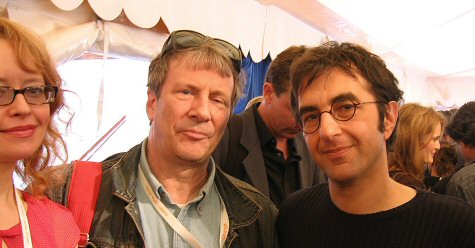
Chicago Tribune reporter Jackie Fitzgerald (far left), film critic Michael Wilmington and Where the Truth Lies director Atom Egoyan (right) at Picturehouse launch party — Saturday, 5.14.05, 6:20 pm.

Last Days star Michael Pitt (l.), Sonic Youth’s Thurston Moore at Picturehouse party — Saturday, 5.14.05, 6:47pm.

.
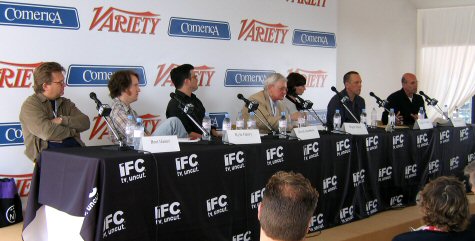
During Variety-sponsored panel discussion among American directors: (l. to r.) Brent Hamer (Factotum), Kyle Henry (Room), David Jacobson (Down in the Valley), host Roger Ebert, Miranda July (Me and You and Everyone We Know), Lodge Kerrigan (Keane) and Stuart Sammuels (Midnight Movies: From the Margin to the Mainstream).
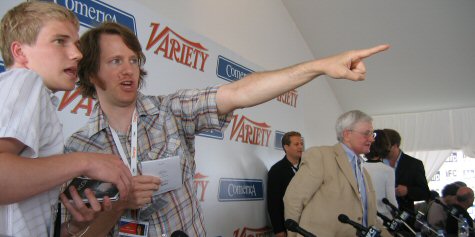
Room director Kyle Henry (sideburns, facial blemish, second from left); panel host Roger Ebert slightly behind and to the right — Saturday, 5.14.05, 4:05 pm.
No Worries
I saw about an hour’s worth of Joyeux Noel at the Salle Bazin earlier today. That’s right — it wasn’t good enough to see through to the end.
It’s a French-produced period drama about the World War I Christmas truce of 1914, written and directed by Christian Clarion. It suffers from a too-modest budget, simplistic writing, the worst dubbing of an actor and actress pretending to be opera singers I’ve ever seen in my life, and a generally sentimental and ham-fisted tone that will almost certainly not play with audiences in the States, if any US distributor is reckless enough to pick it up.
As regular readers know, I ran a piece a few months ago about two other films being planned about this exact same subject.
Vadim Perlman (House of Sand and Fog) is (or was) planning a film called Truce, working from a script by Stuart Beattie. Paul Weitz and his brother Chris have been talking about making a film called Silent Night…exact same deal.
What I’m saying, obviously, is that Perlman and Weitz have only each other to fear…if their respective projects are still on the rails and moving ahead, I mean (which I’m not sure about at this stage)

<div style="background:#fff;padding:7px;"><a href="https://hollywood-elsewhere.com/category/reviews/"><img src=
"https://hollywood-elsewhere.com/wp-content/uploads/2019/08/reviews.jpg"></a></div>
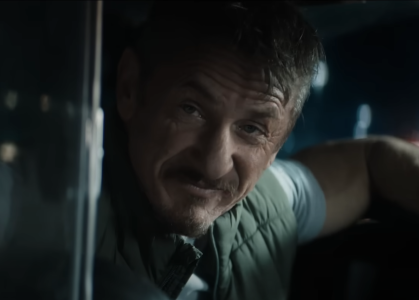 Really Nice Ride
Really Nice RideTo my great surprise and delight, Christy Hall‘s Daddio, which I was remiss in not seeing during last year’s Telluride...
More »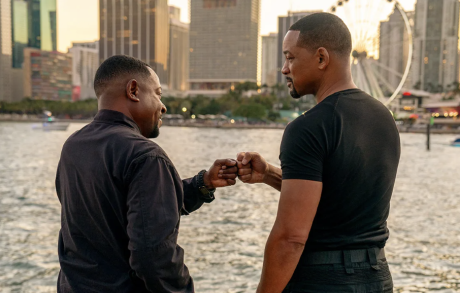 Live-Blogging “Bad Boys: Ride or Die”
Live-Blogging “Bad Boys: Ride or Die”7:45 pm: Okay, the initial light-hearted section (repartee, wedding, hospital, afterlife Joey Pants, healthy diet) was enjoyable, but Jesus, when...
More » One of the Better Apes Franchise Flicks
One of the Better Apes Franchise FlicksIt took me a full month to see Wes Ball and Josh Friedman‘s Kingdom of the Planet of the Apes...
More »
<div style="background:#fff;padding:7px;"><a href="https://hollywood-elsewhere.com/category/classic/"><img src="https://hollywood-elsewhere.com/wp-content/uploads/2019/08/heclassic-1-e1492633312403.jpg"></div>
- The Pull of Exceptional History
The Kamala surge is, I believe, mainly about two things — (a) people feeling lit up or joyful about being...
More » 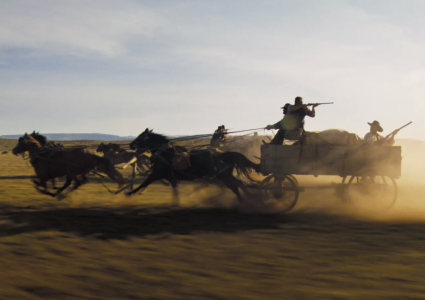 If I Was Costner, I’d Probably Throw In The Towel
If I Was Costner, I’d Probably Throw In The TowelUnless Part Two of Kevin Costner‘s Horizon (Warner Bros., 8.16) somehow improves upon the sluggish initial installment and delivers something...
More » Delicious, Demonic Otto Gross
Delicious, Demonic Otto GrossFor me, A Dangerous Method (2011) is David Cronenberg‘s tastiest and wickedest film — intense, sexually upfront and occasionally arousing...
More »


